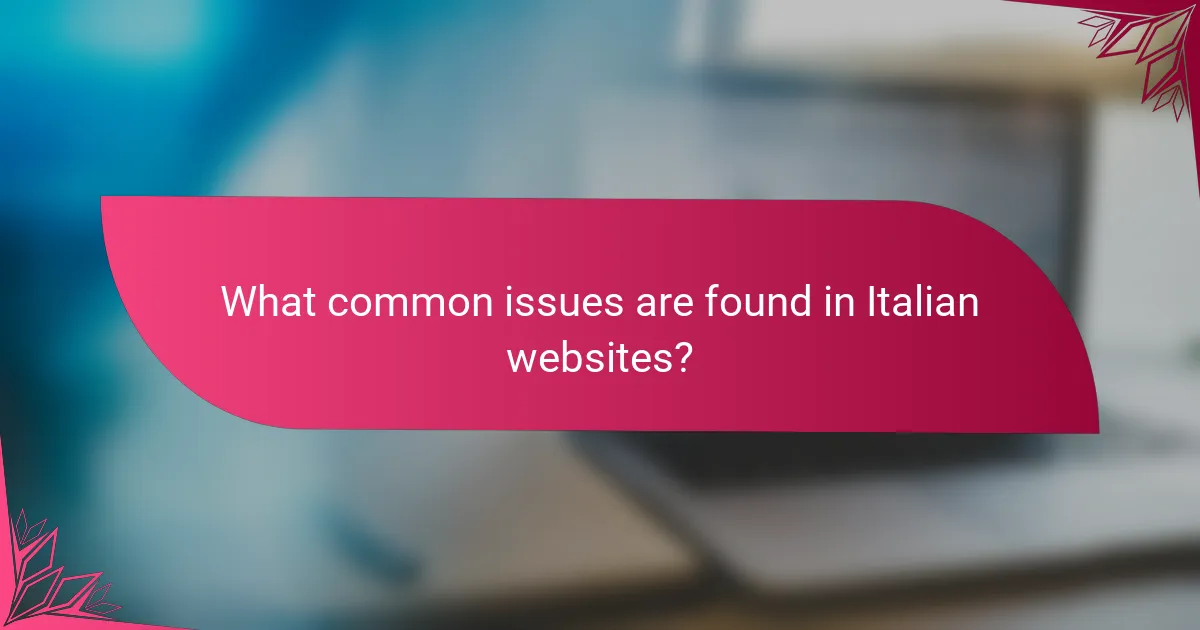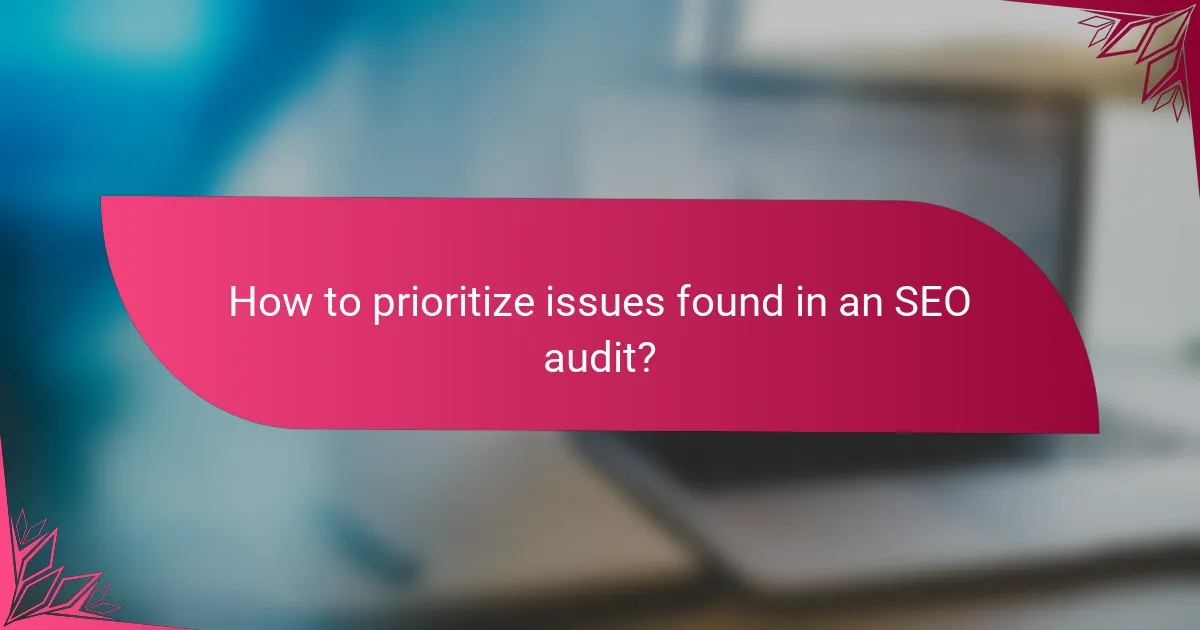Conducting a technical SEO audit for Italian websites is essential for improving visibility and user experience. By focusing on website performance, mobile compatibility, and adherence to local search engine guidelines, businesses can effectively attract and retain visitors. Utilizing tools like SEMrush, Screaming Frog, and Google Search Console can further enhance the audit process, helping to identify and resolve potential issues.

What are the best practices for technical SEO audits in Italy?
Best practices for technical SEO audits in Italy focus on optimizing website performance, ensuring mobile compatibility, and adhering to local search engine guidelines. These strategies enhance visibility and user experience, which are crucial for attracting and retaining visitors.
Mobile optimization strategies
Mobile optimization is essential as a significant portion of users in Italy access websites via smartphones. Ensure your site is responsive, meaning it adjusts seamlessly to different screen sizes. Use tools like Google’s Mobile-Friendly Test to identify issues.
Additionally, prioritize fast loading times on mobile devices. Aim for load times under three seconds to reduce bounce rates. Implementing Accelerated Mobile Pages (AMP) can also enhance mobile performance.
Site speed improvement techniques
Site speed is a critical factor for both user experience and search rankings. To improve speed, compress images and leverage browser caching. Tools like GTmetrix or Google PageSpeed Insights can help identify specific areas for enhancement.
Consider using a Content Delivery Network (CDN) to distribute your content globally, which can significantly reduce load times for users in Italy and beyond. Regularly monitor your site’s speed to ensure it remains competitive.
Structured data implementation
Implementing structured data helps search engines understand your content better, improving visibility in search results. Use Schema.org markup to enhance your site’s snippets, which can lead to higher click-through rates.
For Italian websites, focus on local business schema to provide information like address, phone number, and operating hours. This can help you appear in local search results and Google Maps, driving more traffic to your site.
Content localization tips
Content localization is vital for engaging Italian audiences effectively. Ensure your content is not only translated but also culturally relevant. Use local idioms and references to resonate with your target demographic.
Additionally, consider local SEO practices by incorporating region-specific keywords. Tools like Google Trends can help identify popular search terms in Italy, allowing you to tailor your content accordingly.
URL structure optimization
A clean and logical URL structure enhances both user experience and SEO. Use descriptive keywords in your URLs, and keep them concise. For Italian websites, include relevant terms in Italian to improve local search rankings.
Avoid using complex parameters and ensure your URLs are easy to read. For example, instead of “example.com/page?id=123”, use “example.com/servizio-italiano”. This clarity helps both users and search engines understand your content better.

How to conduct a technical SEO audit for an Italian website?
To conduct a technical SEO audit for an Italian website, start by assessing the site’s structure, performance, and compliance with SEO best practices. This process helps identify issues that could hinder search engine visibility and user experience.
Step 1: Crawl the website
Crawling the website involves using tools like Screaming Frog or Sitebulb to analyze all accessible pages. This step helps uncover issues such as duplicate content, missing metadata, and crawl errors.
Ensure that the crawl settings are appropriate for the Italian market, considering local language and regional variations. Aim to cover all important sections of the site, including subdomains and directories.
Step 2: Analyze site architecture
Site architecture refers to how content is organized and linked within the website. A clear structure enhances user navigation and helps search engines understand the hierarchy of information.
Check for logical categorization of content, proper use of internal links, and a flat architecture that minimizes the number of clicks needed to reach important pages. A well-structured site typically has a maximum of three clicks from the homepage to any other page.
Step 3: Evaluate on-page elements
On-page elements include title tags, meta descriptions, headers, and image alt texts. Each of these should be optimized for relevant keywords while maintaining clarity and relevance to the content.
For Italian websites, ensure that on-page elements are localized, using Italian keywords and phrases. Avoid keyword stuffing; instead, focus on natural language that resonates with the target audience.
Step 4: Check for broken links
Broken links can negatively impact user experience and search engine rankings. Use tools like Ahrefs or Google Search Console to identify any broken internal or external links on the website.
Regularly check for broken links and fix or redirect them promptly. A good practice is to maintain a maximum of 1-2% broken links on a site to ensure optimal performance and user satisfaction.

What tools are recommended for technical SEO audits?
For effective technical SEO audits of Italian websites, several tools stand out for their capabilities. SEMrush, Screaming Frog, and Google Search Console each offer unique features that help identify issues and optimize site performance.
SEMrush for comprehensive analysis
SEMrush is a powerful tool for conducting a thorough technical SEO audit. It provides insights into site health, keyword rankings, and competitive analysis, making it a comprehensive choice for webmasters. Users can generate detailed reports that highlight critical issues like broken links, duplicate content, and site speed.
When using SEMrush, focus on the Site Audit feature, which scans your website and assigns a health score. Regular audits can help track improvements over time and identify new issues as they arise.
Screaming Frog for site crawling
Screaming Frog is an essential tool for crawling websites and identifying technical SEO issues. It allows users to analyze page titles, meta descriptions, headers, and more, providing a clear view of on-page SEO elements. This tool is particularly useful for large websites where manual checks would be impractical.
To maximize Screaming Frog’s effectiveness, set up custom filters to focus on specific issues, such as redirects or missing alt text. Regularly exporting data can help maintain an organized overview of your site’s technical health.
Google Search Console for performance insights
Google Search Console is crucial for monitoring your website’s performance in search results. It provides data on search queries, click-through rates, and indexing status, helping you understand how your site is perceived by Google. This tool is free and offers valuable insights into potential technical issues affecting visibility.
Utilize the Coverage report to identify indexing problems and the Mobile Usability report to ensure your site is mobile-friendly. Regularly checking these insights can help you stay ahead of technical issues that may impact your site’s performance in Italy’s competitive online landscape.

What common issues are found in Italian websites?
Italian websites often face several common issues that can hinder their performance and visibility. These include duplicate content, slow loading times, and poor mobile responsiveness, all of which can negatively impact user experience and search engine rankings.
Duplicate content problems
Duplicate content occurs when identical or very similar content appears on multiple pages within a website or across different sites. This can confuse search engines, leading to lower rankings as they struggle to determine which version to index. For Italian websites, this often happens with product descriptions or articles that are reused across different regions or platforms.
To address duplicate content, use canonical tags to indicate the preferred version of a page. Regularly audit your content to identify and consolidate duplicates. Tools like Google Search Console can help you spot these issues effectively.
Slow loading times
Slow loading times can significantly affect user retention and search engine rankings. Italian websites should aim for loading times under three seconds, as users often abandon sites that take longer. Factors contributing to slow speeds include large image files, excessive scripts, and unoptimized server response times.
To improve loading times, compress images, minimize JavaScript and CSS files, and leverage browser caching. Consider using a Content Delivery Network (CDN) to distribute content more efficiently across different regions in Italy.
Poor mobile responsiveness
Poor mobile responsiveness is a critical issue as more users access websites via smartphones. Italian websites must ensure that their design adapts seamlessly to various screen sizes. A non-responsive site can lead to high bounce rates and lower search engine rankings.
To enhance mobile responsiveness, adopt a responsive web design framework that adjusts layout and content based on the device. Regularly test your site on multiple devices and screen sizes to ensure a consistent user experience. Tools like Google’s Mobile-Friendly Test can help identify areas for improvement.

How to prioritize issues found in an SEO audit?
To effectively prioritize issues found in an SEO audit, focus on the problems that most significantly impact user experience and search rankings. Addressing high-impact issues first can lead to better site performance and improved visibility in search engine results.
Impact on user experience
User experience (UX) is crucial for retaining visitors and encouraging conversions. Issues such as slow loading times, broken links, and poor mobile responsiveness can frustrate users and lead to higher bounce rates. Prioritize fixing these problems to enhance overall satisfaction.
For example, if your site takes longer than three seconds to load, consider optimizing images and leveraging browser caching. Regularly testing your site on various devices can help identify and resolve UX issues effectively.
Effect on search rankings
Search rankings are heavily influenced by technical SEO factors. Issues like missing meta tags, duplicate content, and improper use of header tags can hinder your site’s visibility on search engines. Addressing these issues can lead to improved rankings and increased organic traffic.
Start by ensuring that all pages have unique title tags and meta descriptions. Tools like Google Search Console can help identify indexing issues that may affect your site’s performance in search results. Regularly monitor these factors to maintain and improve your rankings over time.
